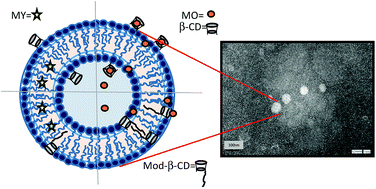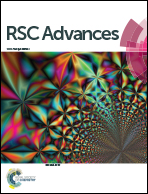Cyclodextrin modified niosomes to encapsulate hydrophilic compounds
Abstract
Niosomes were prepared from equimolar mixtures of two non-ionic surfactants, Span 80 and Tween 80. The capability of the vesicular systems was studied through the encapsulation of two azo dyes as molecular probes of different hydrophobicity (methyl orange (MO) and methyl yellow (MY)). To improve the efficiency of the niosomes to encapsulate the dyes, we employed an additional modification of the vesicular system, adding β-cyclodextrin (β-CD) or a modified amphiphilic β-CD (Mod-β-CD) to the niosomes. Neither the inclusion of dyes nor the incorporation of β-CD to the niosomes produces considerable modifications in size and morphology of the vesicles. However, in the presence of Mod-β-CD the niosomes became smaller, probably due to the anchoring of the cyclodextrin at the surface of vesicles through the hydrophobic chain, altering the curvature of the outer monolayer and reducing the surface charge of the interphase. The entrapment efficiency (EE) for MY was higher than that for MO in niosomes without cyclodextrin, however, the content of MO in the presence of β-CD increased considerably. Besides, the release of this dye under the same conditions was faster and reached 70% in 24 hours whereas in the absence of the macrocycle, the release was 15%, in the same time. UV-visible spectrophotometry and induced circular dichroism analysis allowed it to be established that MO is complexed with cyclodextrins inside vesicles, whereas MY interacts mainly with the niosome bilayer instead of with CD. Besides, the cavity of cyclodextrins is probably located in the interphase and preferably in the polar region of niosomes.



 Please wait while we load your content...
Please wait while we load your content...